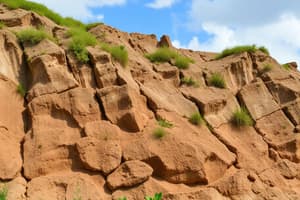Podcast
Questions and Answers
What is the primary difference between hydrolysis and hydration?
What is the primary difference between hydrolysis and hydration?
- Hydrolysis occurs due to water reacting chemically with rocks, while hydration creates fractures and cracks in rocks
- Hydrolysis reacts chemically with rocks, while hydration breaks down rock by acidic water
- Hydrolysis results in erosion by water, while hydration results in erosion by ice
- Hydrolysis produces clay and soluble salts, while hydration modifies the chemical structure of rocks (correct)
What is the primary agent of erosion that changes the shape of the coastline?
What is the primary agent of erosion that changes the shape of the coastline?
- Wind
- Water (correct)
- Ice
- Gravity
What triggers mass wasting?
What triggers mass wasting?
- Erosion by wind
- Lack of vegetation cover (correct)
- Hydration
- Biological weathering
What is the primary process in which earthen materials are worn away and transported by natural forces?
What is the primary process in which earthen materials are worn away and transported by natural forces?
What is the primary outcome of oxidation on rocks?
What is the primary outcome of oxidation on rocks?
What type of weathering is caused by the effects of changing temperatures on rocks?
What type of weathering is caused by the effects of changing temperatures on rocks?
What type of weathering is caused by carbon dioxide in the air dissolving in rainwater and becoming weakly acidic?
What type of weathering is caused by carbon dioxide in the air dissolving in rainwater and becoming weakly acidic?
Freeze-thaw weathering occurs when water continually seeps into cracks, freezes, and expands, eventually breaking the rock apart due to:
Freeze-thaw weathering occurs when water continually seeps into cracks, freezes, and expands, eventually breaking the rock apart due to:
Which process of weathering is caused by organisms like lichens, which are created from algae and fungi?
Which process of weathering is caused by organisms like lichens, which are created from algae and fungi?
What exogenic process involves modifications and transformations of the landforms above the Earth's surface?
What exogenic process involves modifications and transformations of the landforms above the Earth's surface?
Flashcards are hidden until you start studying
Study Notes
Water Interaction Processes
- Hydrolysis involves the chemical reaction between water and minerals, altering the mineral structure, while hydration refers to the physical addition of water molecules to substances without changing their structure.
Coastal Erosion
- The primary agent of erosion that reshapes coastlines is wave action, where the relentless movement of ocean waves can gradually wear away rocks and sediments.
Triggers of Mass Wasting
- Mass wasting is triggered by factors such as heavy rainfall, earthquakes, and volcanic activity, leading to the sudden movement of soil and rock downslope due to gravity.
Weathering and Transport of Materials
- The primary process for wearing away and transporting earthen materials by natural forces is erosion, driven by wind, water, ice, and gravity.
Impact of Oxidation on Rocks
- Oxidation primarily results in the alteration of minerals within rocks, causing them to weaken, change color, and ultimately break down over time.
Temperature-Induced Weathering
- Temperature changes cause physical weathering through expansion and contraction of rock materials, leading to cracks and eventual disintegration.
Acidic Weathering Process
- Weathering caused by carbon dioxide dissolving in rainwater, creating a weakly acidic solution, is known as chemical weathering, which enhances the breakdown of minerals.
Freeze-Thaw Weathering Mechanism
- Freeze-thaw weathering occurs as water seeps into rock cracks, freezes, expands, and ultimately fractures the rock, a process known as repeated freeze-thaw cycling.
Biological Weathering Source
- Weathering caused by organisms such as lichens, which form from symbiotic algae and fungi, is known as biological weathering, as these organisms can produce acids that break down rock.
Exogenic Landform Modification
- The exogenic process that involves modifications and transformations of landforms at the Earth's surface includes weathering, erosion, and deposition, all driven by external forces like wind and water.
Studying That Suits You
Use AI to generate personalized quizzes and flashcards to suit your learning preferences.




